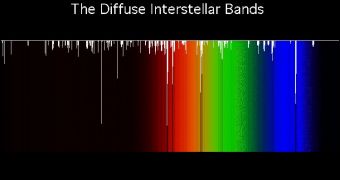Diffuse interstellar bands have been a mystery for astronomers for the better part of 90 years, but a study conducted recently on molecules at the core of the Milky Way may finally solve their riddle.
A long time ago, experts found several types of very odd molecules near the core of our galaxy, which absorbed light at very peculiar wavelengths. Since then, scientists have been using a variety of methods to try and establish the class to which these molecules belong.
However, solving this riddle has proven to be a very complex task. But if experts can figure this out, then they may gain new insights into the nature of interstellar chemistry. It is entirely possible that these molecules could also hold some clues as to how and when life first appeared in the Universe.
It is important to note that light emitted from stars does not reach our vantage point unaltered. Cosmic dust and hydrogen gas, as well as other chemicals and molecules in the interstellar medium, absorb particular wavelengths, filtering the light in specific patterns.
Each of these patterns can be associated with a particular chemical compound or a type of molecule, except for the aforementioned diffuse interstellar bands. These are absorption lines caused by unknown molecules, which researchers have been after for nearly a century, Space reports.
“There have been many suggested identifications of specific molecules for some of the diffuse interstellar bands, and none of them has proven correct,” explains Gemini Observatory astronomer and lead study author Thomas Geballe.
“There is a good general understanding of the chemistry that produces simple molecules like water, carbon monoxide, and ammonia in interstellar space,” the investigator goes on to say.
“However, our knowledge of the more complex chemistry that produces larger molecules is much less secure – in large part because we do not have specific identifications for those large molecules,” he adds. There are currently many scientists who believe the seeds of life came from space.
If this theory – panspermia – turns out to be true, then the earliest chemicals that set the stage for the emergence of life might come from precisely the same range of compounds that creates diffuse interstellar bands. This makes scientists all the more interested in frustrated in the mysterious molecules.
“Most experts in this field think they are likely to be large, carbon-based molecules. They probably are created either in the interstellar clouds where they are found or material ejected from red giants, by chemical reactions in either the interstellar gas or in the red giant winds,” Geballe explains.
“If the molecules producing diffuse interstellar bands are in fact large, carbon-bearing molecules, they could be closely related to molecules important to life such as amino acids and could play an important role is that process. We won't know for sure until we find out exactly what they are,” he adds.
Details of the new analysis were published in the November 2 issue of the top scientific journal Nature.

 14 DAY TRIAL //
14 DAY TRIAL //